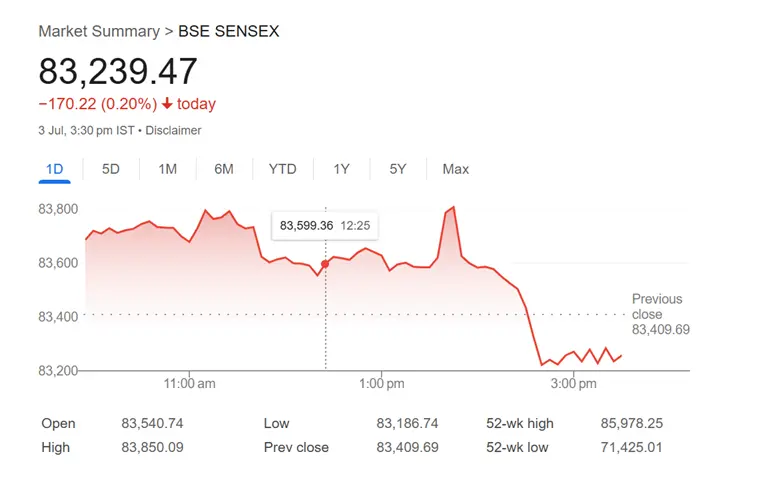
The Sensex closed 170 points lower on July 3 after a volatile session, retreating from early gains as investors weighed US-India trade deal uncertainty and sectoral weakness
From Surge to Slide: Sensex Ends Lower After Intraday High
Sensex Ends Lower – The Indian stock market witnessed a rollercoaster session on July 3, 2025, as the BSE Sensex swung between optimism and caution before closing 170 points lower at 83,239.7. The Nifty 50 mirrored the trend, ending the day at 25,405.3, down 48.1 points.
The day began on a high note, with the Sensex surging over 440 points in early trade, buoyed by positive cues from global markets and optimism surrounding a potential India-US trade agreement. However, the momentum faded as the session progressed, with late selling pressure erasing earlier gains.
Market experts attributed the volatility to a mix of weekly F&O expiry, foreign fund outflows, and uncertainty over the 90-day tariff pause between India and the US. The broader market sentiment remained cautious, with investors reluctant to take aggressive positions ahead of key global developments.
Sectoral Snapshot: PSU Banks, Metals Drag; Auto, Pharma Shine
The sectoral performance painted a mixed picture. PSU banks were the biggest laggards, with the Nifty PSU Bank index falling 0.89%, led by losses in Punjab National Bank, Union Bank of India, and UCO Bank. The metal and realty sectors also ended in the red, reflecting profit booking after recent rallies.
On the brighter side, auto, pharma, and media stocks provided some cushion. The Nifty Auto index rose 0.5%, while pharma and media gained 0.3% and 0.8% respectively. Stocks like Maruti Suzuki, Infosys, NTPC, and Asian Paints were among the top gainers on the Sensex, helping limit the downside.
The Nifty Midcap100 index closed flat with a slight positive bias, while the Nifty Smallcap100 edged up 0.2%, indicating selective buying in broader markets. However, the advance-decline ratio remained nearly even, suggesting a lack of strong directional conviction.
In the derivatives segment, analysts noted a shift in sentiment. Call writers dominated at higher levels, particularly at the 25,600 strike, which now holds the highest open interest. This suggests that 25,600 may act as a near-term resistance, while 25,000 remains a strong support zone.
Global Cues and Investor Outlook: What Lies Ahead?
The market’s cautious tone was amplified by global developments. The India-US trade deal, which could influence tariff structures and foreign capital flows, remains a key overhang. With the 90-day tariff pause nearing its end, investors are closely watching for any breakthrough or escalation.
Meanwhile, the Indian rupee strengthened to a one-month high, supported by expectations of foreign inflows and a weakening US dollar. This could provide some relief to import-heavy sectors and help stabilize inflationary pressures.
Looking ahead, analysts expect the market to remain in a consolidation phase, with 25,200–25,750 likely to be the trading range for the Nifty in the near term. The upcoming earnings season, FII activity, and global macro cues will be critical in determining the next leg of the market’s journey.
Ajit Mishra of Religare Broking noted, “The overall trend remains bullish unless the index decisively breaks below 25,200. Stock-specific opportunities continue to emerge, especially in sectors showing rotational strength.”
Final Thoughts:
July 3’s market action was a classic case of hope meeting hesitation. While early gains reflected optimism, the eventual pullback underscored the fragility of sentiment in a globally interconnected market. As investors await clarity on trade deals and earnings, volatility may remain the name of the game.
Sensex Sinks Over 500 Points: Tariff Jitters and Global Cues Rattle Investor Confidence
‘Heads of State’ Explodes Onto Prime Video with Star Power and Satirical Swagger